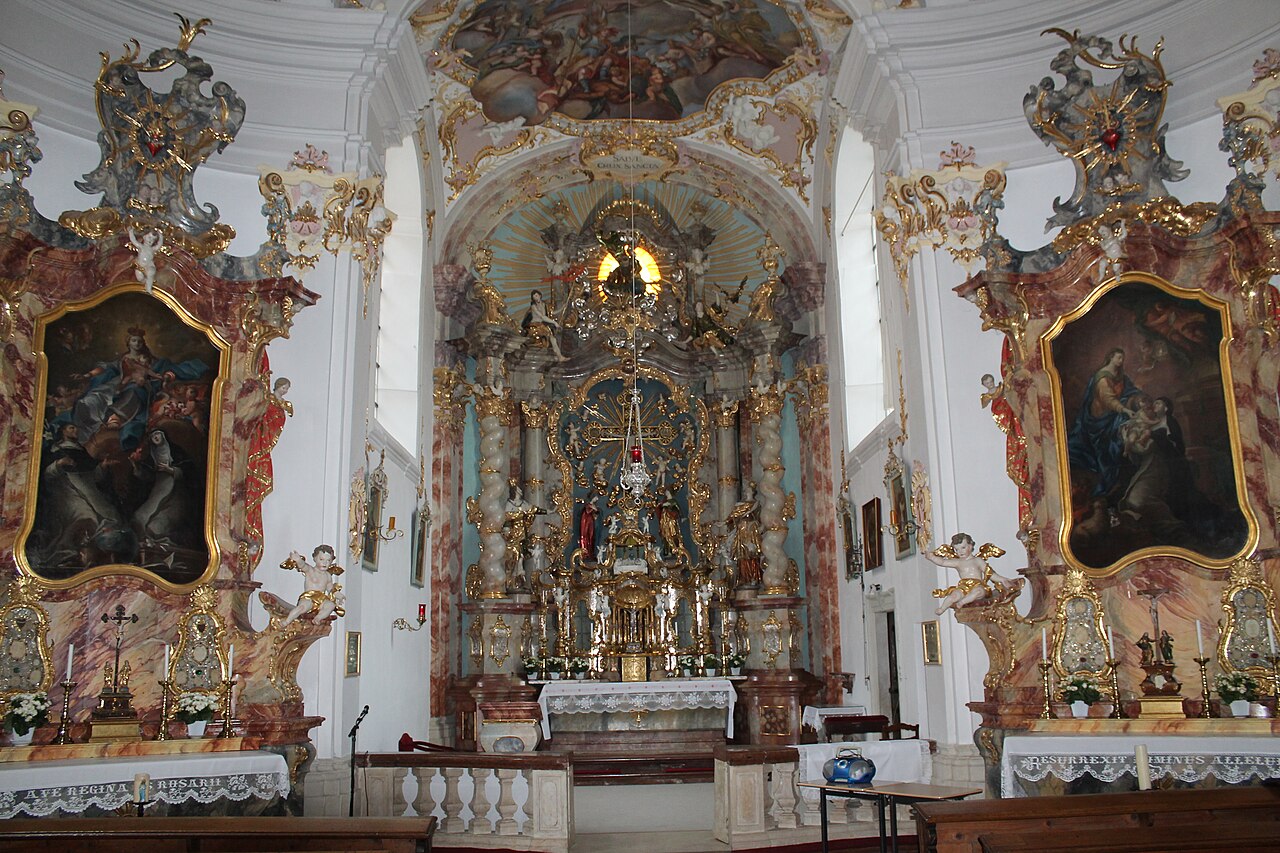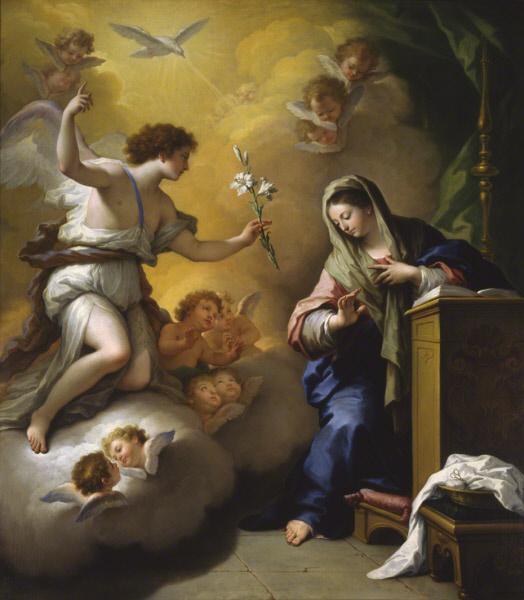The Seven Sorrows of The Blessed Virgin Mary.
Feast Day 15 September.
Double of The Second-Class.
White Vestments.
Text and Illustrations from Wikipedia - the free encyclopaedia,
unless otherwise stated.
English: Our Lady of Sorrows. 1816.
Español: Nuestra Señora de los Dolores. 1816.
Fernando Estévez de Salas,
Parroquia de San Juan Bautista, Villa de La Orotava.
Photo: 2 April 2010.
Source: Own work.
Author: JosuHdez.
(Wikimedia Commons)
As Mater Dolorosa, it is also a key subject for Marian Art in The Catholic Church.
The Seven Sorrows of Mary are a popular Roman Catholic Devotion. There are Devotional Prayers which consist of Meditations on her Seven Sorrows. Examples include The Servite Rosary, or The Chaplet of The Seven Sorrows of Our Lady. Also, there is a corresponding Devotion to The Seven Joys of Mary. The term "Sorrowful and Immaculate Heart of Mary" refers to the combined Devotion of both The Immaculate Heart and The Seven Sorrows of Mary, as first used by The Franciscan Tertiary, Berthe Petit.
The Prophecy of Simeon. (Luke 2:34-35) or the Circumcision of Christ;
The Flight into Egypt. (Matthew 2:13);
The Loss of The Child Jesus in the Temple. (Luke 2:43-45);
Mary Meets Jesus on The Way to Calvary.;
Jesus Dies on The Cross. (John 19:25);
Mary Receives The Body of Jesus in Her Arms. (Matthew 27:57-59);
The Body of Jesus Is Placed in the Tomb. (John 19:40-42).
These Seven Sorrows should not be confused with The Five Sorrowful Mysteries of The Rosary.

Mater Dolorosa with open hands.
Artist: Titian (1490–1576).
Date: 1555.
Current location: Prado Museum, Madrid, Spain.
Source/Photographer: http://www.museodelprado.es/
(Wikimedia Commons)
Over the Centuries, several Devotions, and even Orders, arose around Meditation on Mary's Sorrows. The Servites developed the two most common Devotions to Our Lady's Sorrows, namely The Rosary of The Seven Sorrows and The Black Scapular of The Seven Dolours of Mary. The Black Scapular is a symbol of The Confraternity of Our Lady of Sorrows, which is associated with The Servite Order. Most devotional Scapulars have requirements regarding ornamentation or design. The Devotion of The Black Scapular requires only that it be made of Black Woollen Cloth.
English: Our Lady, Who Softens Evil Hearts.
Russian icon, 19th-Century.
Русский: Икона "Умягчение злых сердец".
Source: http://days.pravoslavie.ru.
Author: Unknown.
(Wikimedia Commons)
It depicts The Virgin Mary at the moment that Simeon the Righteous says: "Yea, a Sword shall pierce through thy own Soul also . . ." (Luke 2:35). She stands with her hands upraised in Prayer, and Seven Swords pierce her Heart, indicative of The Seven Sorrows. This is one of the few Orthodox icons of The Theotokos which do not depict The Infant Jesus. The Refrain "Rejoice, much-sorrowing Mother of God, turn our sorrows into joy and soften the hearts of evil men !" is also used.
The first Altar to The Mater Dolorosa was set up in 1221 at the Monastery of Schönau. Especially in Mediterranean Countries, Parishioners traditionally carry statues of Our Lady of Sorrows in Processions on the days leading to Good Friday.
No Feast in her honour was included in Pope Saint Pius V's 1570 Tridentine Calendar. Vatican approval for the Celebration of a Feast, in honour of Our Lady of Sorrows, was first granted to The Servite Order in 1667.

English: Our Lady of Sorrows, El Viso del Alcor, Seville, Spain.
Español: Nuestra Señora de los Dolores. Capilla del Sagrario
de la Iglesia Parroquial de Santa María del Alcor.
El Viso del Alcor (Sevilla). Procesiona bajo palio
en la tarde noche del Viernes Santo
Photo: 8 December 2007.
Source: Own work.
Author: Ajjb.
(Wikimedia Commons)
Another Feast, originating in the 17th-Century, was extended to the whole of The Latin Church in 1727. It was originally Celebrated on Friday in Passion Week, one week before Good Friday. In 1954, it still held the Rank of Major Double (slightly lower than the Rank of the 15 September Feast) in The General Roman Calendar.
Each Celebration was called a Feast of "The Seven Sorrows of The Blessed Virgin Mary."
The 15 September Feast, that now combines and continues both of them, is known as The Feast of "Our Lady of Sorrows" (Beatae Mariae Virginis Perdolentis). The Sequence, known as Stabat Mater, may be sung at Mass on that day.
by the Master of the Stauffenberg Altarpiece, Alsace, circa 1455.
Title: La descente de Croix, les larmes de Marie (detail).
Current location: Unterlinden Museum, France.
Source/Photographer: Own work, Alsace, Haut-Rhin, Colmar,
les larmes de Marie., vincent desjardins, 2008-12-27.
(Wikimedia Commons)
In this iconography, Our Lady of Seven Sorrows is at times simply represented in a sad and anguished mode by herself, her expression being that of tears and sadness. In other representations, The Virgin Mary is depicted with Seven Swords in her Heart, a reference to the Prophecy of Simeon, at The Presentation.
Our Lady of Sorrows is The Patron Saint of:
the State of Mississippi, USA;

THE SAINT ANDREW DAILY MISSAL
THE SAINT ANDREW DAILY MISSAL
Available (in U.K.) from
Available (in U.S.A.) from


.jpg&container=blogger&gadget=a&rewriteMime=image%2F*)













.jpg)

.bmp)

.jpg)




.jpg)

